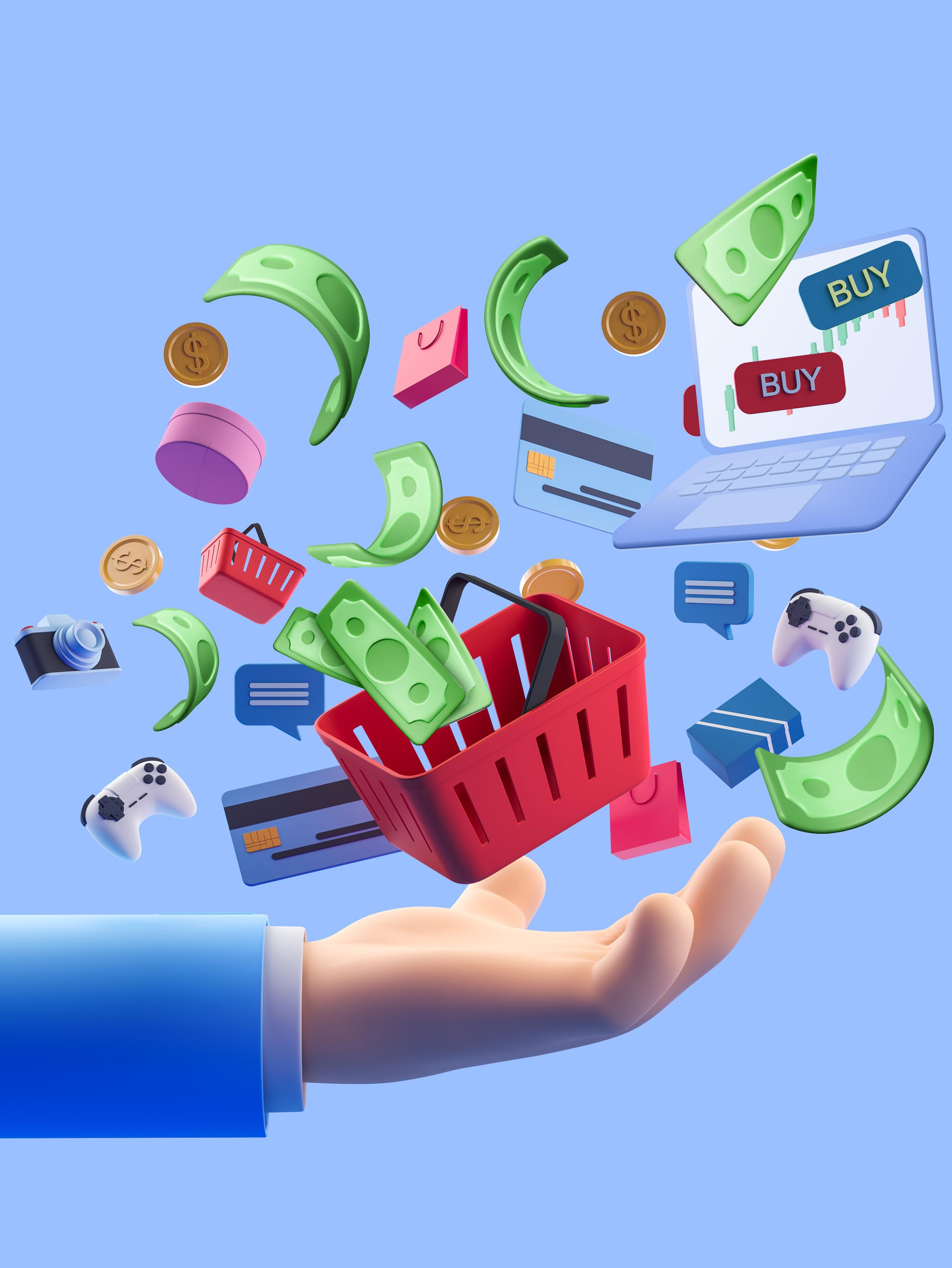
9 minute read
Online shopping: The money spinner
If Correspondent
E-commerce penetration across all categories continues to grow after an extraordinary rise in online retail spending in 2020, a much-needed and profitable development. As lockdowns and trade disruptions resulting from the COVID-19 outbreaks continued to plague the world from 2020-2022, retail online sales increased by 40% in 2021 alone, as consumers increased their usage of online shopping portals to purchase items, be it the ones coming the category of daily necessities or the high-end products.
Across all product categories, from consumer electronics to groceries, about 75% of consumers conduct product research and purchase through brick-and-mortar stores and online channels.
A recent study and analysis by McKinsey provide a thorough look at the direction that e-commerce in consumer products will go over the coming year. E-commerce's development will continue after the COVID-19 pandemic and the current expansion.
The emergence of new platforms, channels, and data sources will never stop. Consumer products companies face opportunities and challenges when deciding how to engage their customer groups most effectively due to this dynamic.
Aware of the potential effects on their balance sheets, executives must carefully consider their investments as they explore cutting-edge technologies like the metaverse and live selling. They must also have the organizational capacity to change course quickly and successfully to potentially better ground.
Complicated consumer landscape
Over 2024, three developments will likely impact how consumer goods companies locate, assess, and seize opportunities.
Firstly, there will always be new ways to reach consumers. Consumer products firms typically participated in a few e-commerce channels, with Amazon taking the lead. To stay current with where consumers interact and shop, consumer products companies must be present on a wide range of new platforms and formats.
Consumer demand for omnichannel fulfilment options for in-store purchasing, including home delivery (from a neighbourhood store), ship-tohome (from a distribution centre), and click-and-collect, is increasing. Between 2021 and 2025, social commerce, which broadens reach by selling through social media channels, is anticipated to more than double and account for nearly $80 billion in retail sales.
The United States is now only second to China in terms of social purchasing thanks to this rapid expansion, where that channel currently accounts for more than 13% of the global e-commerce market.
New entrants like JOKR and Gopuff are changing customer expectations about delivery speed due to the expansion of quick commerce (home delivery in under an hour and as quickly as 15 minutes). Although this channel is only expected to account for a small portion of overall grocery e-commerce sales, it already has a significant impact. In 2021, about 30% of online grocery shoppers chose delivery in two hours or less, and 14% of customers said they planned to use express and same-day delivery more often. There will be more competition for marketing and trade dollars.
E-commerce has made it more difficult for businesses to be profitable, prompting merchants to look for new ways to boost margins. For instance, retail media networks (RMNs) allow merchants to monetize their first-party customer data by letting marketers place ads on their websites.
A significant incentive for shops to enter the fray is Amazon's expanding ad business, based on the same rich transaction data that all merchants have access to. The shift in consumer tastes and legislation surrounding data privacy has increased the appeal of closed-loop channels built on entirely user-consented first-party data, thus fueling the growth of commerce media. Over the past two years, more than a dozen merchants have introduced RMNs, and others plan to do the same shortly.
Approximately 15% of all advertising and promotion spending is already going toward commercial media, which typically accounts for between 2% and 10% of gross sales (depending on the subcategory), according to a survey of 100 consumer goods e-commerce decision-makers. By 2024, spending in the channel is anticipated to exceed $100 billion (including Amazon), increasing by a factor of two to three annually.
Using commercial media will initially be difficult for consumer products companies since it puts additional pressure on their marketing budgets and profit-and-loss (P&L) ratio. However, if properly managed, it will enable consumer goods companies to
The Growth in Retail Ecommerce Sales
Worldwide 2021-2026 (In Trillion US Dollars) 2021
5.211 2022
5.717 2023
6.310 enhance both the buyer experience and marketing effectiveness.
Approaches like RMNs can offer a customized, personalized experience that suits changing customer privacy, control, and transparency requirements. Companies that sell consumer goods can also utilize commercial media to improve the data that forms the basis of their targeting and closedloop attribution systems. Consumer products firms can increase return on ad investment in this new channel by three to five times if they implement these strategies well.
Personalization and targeted precision will take the place of all other considerations. There is now an unprecedented amount of data available on how people shop and interact with brands, thanks to the rise of online transactions and the general digitization of commerce. With the change to online transactions, businesses now better understand the customer experience, including measures like cart abandonment, add-to-cart rates, browsing habits, and time to purchase. Given their close interaction with customers, retailers are especially wellpositioned to collect these data, which they have been using to develop more individualized experiences. As a result, customers have quickly come to demand businesses to provide personalized, pertinent interactions.
Consumer products firms may collect data at a different rate than retailers. Still, to fulfil the increasingly high client personalization standards and realize returns on their investments, they have had to develop more sophisticated data management capabilities.
Practical strategies

Winning consumer goods companies invest in five crucial areas to differentiate themselves in the ever-changing e-commerce landscape. Additionally, they are trying to ensure that every aspect of their organizations, from resources, talent, and skills to processes and culture, is in place to support these objectives properly.
For starters, the emphasis on CRO (conversion rate optimization) in recent years in e-commerce has made many businesses ignorant of the apparent requirement that CRO requires the consumer to visit your site. This necessitates work to persuade them to do so, necessitating right away a second tier of marketing with associated added expense. Before big platforms like Amazon and Alibaba get a look in, predictive personalization software (PPS) enters the fray and brings that personalization to your customers, with the advantage of generating purchases.
In addition to buying history, impressions, and navigation, choosing impending product choices individually is based on these factors and AI analysis with machine learning, which correctly predicts what each person is most likely to buy next and presents it to them at the ideal time.
There is no need for additional marketing levels; the absolute autonomy reduces the necessity for previously anticipated layers. There are also no overhead costs or employees. Additionally, freedom means it is always operational and free from mistakes, oversights, and other human flaws typically associated with functional performance. The age of automated email marketing has arrived, which explains why it produces results that defy all logic, an example of predictive personalization that exceeded 10,000% ROI.



Another helpful strategy is to be present wherever consumers shop— in a focused and deliberate manner. Winners engage customers in their preferred method by carefully and intentionally using a wide range of e-commerce platforms. Compared to 25% of their competitors, two-thirds of winning consumer products businesses intend to sell through food-delivery media (such as DashMart by DoorDash and Cornershop by Uber) within the following year.
Consumer goods companies need to be where their customers are, as new platforms emerge, players that can quickly adopt them will be best positioned. Approximately 20% of winners intend to sell through social media like TikTok and WhatsApp, even though the purchasing capabilities of these platforms are just coming into existence.
Staying on top of consumer trends that affect channel preferences will be critical to increasing online sales and finding new ways to reach households. Leading consumer goods companies quickly develop perspectives on the channel's relevance to their consumers and determine action plans for product placement.
Adjusting procedures, organizational design, and resources to accommodate this capacity gap will reduce response times and boost speed to market. Selling through these platforms may force B2B2C organizations to build new competencies.

A third idea would be to make data and analytics investments to support adaptable, full-funnel marketing. Winners are building owned, contentfirst online platforms and loyalty programs designed to enhance consumer engagement through rewards or services as marketers lose access to third-party data. For instance, a leading packaged-food company with an extensive loyalty program recently revamped its strategy for digital formats by building a proprietary mobile application specifically for its rewards program.
Companies can aggregate transaction data, media exposure and interaction data, website activity, firstparty data, and additional data sets to link a consumer ID across multiple data systems. Winning companies invest in the right tools, partnerships, and capabilities to build an internal 360-degree view of consumers to meet shoppers' increased demand for personalization.
With the help of this data, businesses can develop fully automated, repeatable, scalable methodologies to identify future activation opportunities in a personalized way, capturing meaningful business value. For instance, a food company recently increased the return on its digital advertising spend by more than 40% by using first-party data to target audiences that look like its target audiences.
Also, keeping a laser-like focus on ongoing development by establishing cross-functional teams, or "pods," to foster daily, purpose-driven collaboration among marketing, sales, creative, technology, data and analytics, and more on an ongoing basis, winning consumer goods companies are embracing agile operating models that accelerate the pursuit of opportunities, improve execution outcomes, and unlock value.

Agile pods need dedicated data scientists and engineers to execute a standard measurement playbook and continuous improvements. Gone are the days of gut-feeling-driven decisionmaking across merchandising, pricing, promotions, assortment, and content online. Execution decisions will be based on granular insights. Consumer goods companies can differentiate themselves by their ability to operate these pods and build actual test-andlearn muscles.
The survey results demonstrate the adoption of these new methods of operation and the emphasis on continuous, data-driven improvement. The winners are 21% more likely than other consumer product companies to prioritize test-and-learn processes to enhance online performance.
For instance, by quickly testing and identifying the most effective tactics across core performance levers, a leading cosmetics manufacturer launched an agile pod initially focused on Amazon. As a result, the business gained insights into particular actions, made adjustments based on specific learnings, and quickly scaled to achieve a certain, quantified goal.
The company is now looking into creating a more comprehensive, formalized test-and-learn program across additional channels and retail partners due to the company's experiment, which led to a doubling of sales on Amazon and a four-fold acceleration of the creative development process.
Finally, it is best to invest in digital talent before it becomes obsolete. While relying on third-party agencies or partners may boost sales in the short term, excessive reliance on external providers over a long time may hinder a company's ability to increase e-commerce sales in the fastest, most effective manner. Foundational digital literacy and analytics capabilities are critical to achieving a long-term competitive advantage in e-commerce. To do so requires in-house proficiency in technical talent, tools, and abilities.
Leading household goods company launched a formal mentorship program between senior executives and junior marketing analytics employees with the dual goals of increasing fluency among senior leaders in direct-to-consumer functions and mentoring more junior colleagues. Winning consumer goods companies recognize that digital fluency must be embedded at all levels of the organization, from the front line to the C-suite.

Perhaps most importantly, the initiative generated demand for digital solutions across the organization and created momentum for further digital capability development. Executives learned the power of differentiating proprietary data, including attribution modelling, performance marketing, personalization, and more.
It's also important to rethink the supply chain from beginning to end to accommodate omnichannel expansion. Winners make foundational investments in operations and supply chain management. They are up to three times more likely to make supply chain management an organizational priority. They are 40% more likely to see it as a critical obstacle in attaining their e-commerce goal.
First, they integrate more closely with retail partners to improve demand forecasting, inventory management, packaging design, and fulfilment. For instance, winners are roughly four times more likely than others to participate in Amazon's Vendor Flex program, which allows purchases to be shipped directly from the consumer goods company's warehouse to consumers. Second, winning consumer goods companies concentrate on two critical operations and supply chain areas.
Second, winners are examining what is ideal for brick-and-mortar business and online fulfilment (from home shipping delivery), using an omnichannel manufacturing and packaging design strategy.
For instance, a well-known retailer of household goods switched to "ship in own container" packaging, which increases sustainability, lessens wrap rage (the rage and frustration a customer feels when they can't open a product's packaging), and is frequently much less expensive to store and ship than conventional retail packaging. Several consumer goods manufacturers have experimented with pack sizes and product formulations to reduce shipping weight.
There are other keys to winning in e-commerce than optimizing the current business to compete in the digital sphere. Instead, it adopts an omnichannel-first perspective to rethink the company. Onthe-margin adjustments to the current operating margin do not produce winners in anything, from commercial decisions and procedures to talent and human capital management and data.
The "current" channels and platforms may be prominent, but the digital world is a moving, always-changing target. Organizations must outsmart the competition by being quick and digitalfirst to succeed in this market.
Winning in this market will take more than executing well on opportunities now. Businesses prioritizing digital across only some organizational functions risk losing market share, profitability, and relevance shortly.









